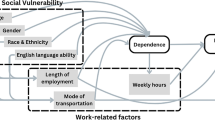Abstract
It has been reported that weather-related high ambient temperature is associated with an increased risk of work-related injury. Understanding this relationship is important because work-related injuries are a major public health problem, and because projected climate changes will potentially expose workers to hot days, including consecutive hot days, more often. The aim of this study was to quantify the impact of exposure to sustained periods of hot weather on work-related injury risk for workers in Melbourne, Australia. A time-stratified case crossover study design was utilised to examine the association between two and three consecutive days and two and three consecutive nights of hot weather and the risk of work-related injury, using definitions of hot weather ranging from the 60th to the 95th percentile of daily maximum and minimum temperatures for the Melbourne metropolitan area, 2002–2012. Workers’ compensation claim data was used to identify cases of acute work-related injury. Overall, two and three consecutive days of hot weather were associated with an increased risk of injury, with this effect becoming apparent at a daily maximum temperature of 27.6 °C (70th percentile). Three consecutive days of high but not extreme temperatures were associated with the strongest effect, with a 15% increased risk of injury (odds ratio 1.15, 95% confidence interval 1.01–1.30) observed when daily maximum temperature was ≥33.3 °C (90th percentile) for three consecutive days, compared to when it was not. At a threshold of 35.5 °C (95th percentile), there was no significant association between temperature and injury for either two or three consecutive days of heat. These findings suggest that warnings to minimise harm to workers from hot weather should be given, and prevention protocol initiated, when consecutive warm days of temperatures lower than extreme heat temperatures are forecast, and well before the upper ranges of ambient daytime temperatures are reached.

Similar content being viewed by others
References
Adam-Poupart A, Smargiassi A, Busque M-A, Duguay P, Fournier M, Zayed J, Labrèche F (2015) Effect of summer outdoor temperatures on work-related injuries in Quebec (Canada) Occ. Environ Med 72:338–345. https://doi.org/10.1136/oemed-2014-102428
Australian Bureau of Meteorology (2010) Thermal comfort observations Available at: http://www.bom.gov.au/info/thermal_stress/. Accessed 26 May 2017
Australian Bureau of Meteorology (2016a) Climate Glossary Available at: http://www.bom.gov.au/climate/glossary/mid_latitudes.shtml. Accessed 4 November 2016
Australian Bureau of Meteorology (2016b) State of the Climate 2016. Available at http://www.bom.gov.au/state-of-the-climate/State-of-the-Climate-2016.pdf. Accessed 20 December 2016
Australian Bureau of Meteorology (2017) Annual Climate Statement:2016 http://www.bom.gov.au/climate/current/annual/aus/. Accessed 15 February 2017
Australian Bureau of Statistics (2013) 2011 Census Quick Stats http://www.censusdata.abs.gov.au/census_services/getproduct/census/2011/quickstat/LGA20660?opendocument&navpos=220
Australian Bureau of Statistics (2016a) Regional population growth, Australia, 2014–15. Cat no 3218.0 http://www.abs.gov.au/AUSSTATS/abs@.nsf/Previousproducts/3218.0Main%20Features252014-15?opendocument&tabname=Summary&prodno=3218.0&issue=2014-15&num=&view=
Australian Bureau of Statistics (2016b) Data by region, Cat No. 1410
Australian Workers' Union (2016) AWU Victorian Branch Model Clause for Construction Enterprise Agreements in relation to heat Available at https://vic.awu.net.au/heat-stress. Accessed 30 October 2016
CFMEU Construction Inclement weather - Heat Policy. CFMEU South Australia. http://www.cfmeu.asn.au/branch/sa/campaign/inclement-weather-heat-policy. 2016
Checkoway H, Pearce N, Kriebel D (2007) Selecting appropriate study designs to address specific research questions in occupational epidemiology. Occup Environ Med 64:633–638
Government of Canada (2011) Human resources & skills development Canada. National occupational classification career handbook. Ottawa, ON
Hajat S, Kosatky T (2010) Heat-related mortality: a review and exploration of heterogeneity. J Epidemiol Community Health 64:753–760. https://doi.org/10.1136/jech.2009.087999
Holder Y, Peden M, Krug E, Lund J, Gururaj G, Kobusingye O (2001) Injury surveillance guidelines. Geneva, World Health Organisation, 2001p5 Available at: http://appswhoint/iris/bitstream/10665/42451/1/9241591331pdf. Accessed 4 May 2017
International Labour Organisation (2016) Safety and Health at Work http://www.ilo.org/global/topics/safety-and-health-at-work/lang--en/index.htm. Accessed 28 December 2016
IPCC (2013) Summary for policymakers. In: climate change 2013: the physical science basis. Contribution of working group I to the fifth assessment report of the intergovernmental panel on climate change [stocker, T.F., D. Qin, G.-K. Plattner, M. Tignor, S. K. Allen, J. Boschung, A. Nauels, Y. Xia, V. Bex and P.M. Midgley(eds.)]. Cambridge University press, Cambridge, United Kingdom and New York, NY, USA
Janes H, Sheppard L, Lumley T (2005) Case-crossover analyses of air pollution exposure data: referent selection strategies and their implications for bias. Epidemiology 16:717–726
Kenny GP, Yardley J, Brown C, Sigal RJ, Jay O (2010) Heat stress in older individuals and patients with common chronic diseases. Can Med Assoc J 182:1053–1060. https://doi.org/10.1503/cmaj.081050
Maclure M (1991) The case-crossover design: a method for studying transient effects on the risk of acute events. Am J Epidemiol 133:144–153
Maclure M, Mittleman MA (2000) Should we use a case-crossover design? Annu Rev Public Health 21:193–221. https://doi.org/10.1146/annurev.publhealth.21.1.193
McInnes JA, Akram M, MacFarlane EM, Keegel T, Sim MR, Smith P (2017) Association between high ambient temperature and acute work-related injury: a case-crossover analysis using workers’ compensation claims data. Scand J Work Environ Health 43:86–94. https://doi.org/10.5271/sjweh.3602
McInnes JA, Clapperton AJ, Day LM, MacFarlane EM, Sim MR, Smith P (2014) Comparison of data sets for surveillance of work-related injury in Victoria, Australia. Occup Environ Med 71:780–787. https://doi.org/10.1136/oemed-2014-102243
McInnes JA, MacFarlane EM, Sim MR, Smith P (2016) Working in hot weather: a review of policies and guidelines to minimise the risk of harm to Australian workers injury prevention. https://doi.org/10.1136/injuryprev-2016-042204
Morabito M, Cecchi L, Crisci A, Modesti PA, Orlandini S (2006) Relationship between work-related accidents and hot weather conditions in Tuscany (central Italy) Ind Health 44. https://doi.org/10.2486/indhealth.44.458
Nicholls N, Skinner C, Loughnan M, Tapper N (2008) A simple heat alert system for Melbourne, Australia. Int J Biometeorol 52:375–384. https://doi.org/10.1007/s00484-007-0132-5
Parsons KC (2003) Human thermal environments: the effects of hot, moderate, and cold environments on human health, comfort and performance, 2nd edn. Taylor & Francis, London
Prang K-H, Hassani-Mahmooei B, Collie A (2016) Compensation research database: population-based injury data for surveillance, linkage and mining. BMC Research Notes 9:1–11. https://doi.org/10.1186/s13104-016-2255-4
Productivity Commission (2013) An ageing Australia: preparing for the future. Commission Research Paper Overview, Canberra
Safe Work Australia (2011) Work-related injuries in Australia: who did and didn’t receive workers’ compensation in 2009–10. http://www.safeworkaustralia.gov.au/sites/swa/about/publications/pages/work-relatedinjuriesinaustralia2009-10. Accessed 2 Sept 2013
Safe Work Australia (2015) The cost of work-related injury and illness for Australian employers. Workers and the Community:2012–2013
Salminen S et al (2010) Sleep disturbances as a predictor of occupational injuries among public sector workers. J Sleep Res 19:207–213. https://doi.org/10.1111/j.1365-2869.2009.00780.x
Smith PM, Berecki-Gisolf J (2014) Age, occupational demands and the risk of serious work injury occupational medicine -Oxford- 64:571-576
Spector JT, Bonauto DK, Sheppard L, Busch-Isaksen T, Calkins M, Adams D et al (2016) A case-crossover study of heat exposure and injury risk in outdoor agricultural workers. PLoS One 11:e0164498. https://doi.org/10.1371/journal.pone.0164498
Sports Medicine Australia (2007) Hot weather guidelines Available at http://sma.org.au/wp-content/uploads/2009/05/hot-weather-guidelines-web-download-doc-2007.pdf. Accessed 30 October 2016
State Government of Victoria (2016) Interactive map Available at http://services.land.vic.gov.au/landchannel/jsp/map/InteractiveMapIntro.jsp. Accessed 29 December 2016
Tobías A, de Olalla PG, Linares C, Bleda MJ, Caylà JA, Díaz J (2010) Short-term effects of extreme hot summer temperatures on total daily mortality in barcelona, spain. Int J Biometeorol 54:115–117
Victorian Government Department of Health (2012) Heat health alert system 2012–2013. Available at http://www.health.vic.gov.au/environment/heatwaves-alert.htm. [verified 12 May 2013]
Victorian Workcover Authority (2008) VCODE the nature of injury/disease classification system for Victoria, version 1.2, Worksafe Victoria
WorkSafe Victoria (2012) Statistical Summary 2011–12. http://www.worksafe.vic.gov.au/forms-and-publications/forms-and-publications/statistical-summary2. Accessed 8 June 2016
World Meteorological Organisation (2016) Press Release No. 15: Provisional Statement on Status of Climate in 2016: Continuing high temperatures globally and many climate extremes worldwide Available at: https://public.wmo.int/en/media/press-release/provisional-wmo-statement-status-of-global-climate-2016
Xiang J, Bi P, Pisaniello D, Hansen A (2014a) The impact of heatwaves on workers health and safety in Adelaide South Australia. Environ Res 133C. https://doi.org/10.1016/j.envres.2014.04.042
Xiang J, Bi P, Pisaniello D, Hansen A, Sullivan T (2014b) Association between high temperature and work-related injuries in Adelaide, South Australia, 2001–2010 Occ. Environ Med 71:246–252. https://doi.org/10.1136/oemed-2013-101584
Acknowledgements
Compensation claim administrative data was provided by the Institute for Safety, Compensation and Recovery (ISCRR), based within Monash University. Whilst completing this work, Peter Smith was supported by a discovery Early Career Researcher Award from the Australian Research Council, and through a Research Chair in Gender, Work and Health from the Canadian Institutes of Health Research.
Author information
Authors and Affiliations
Corresponding author
Electronic supplementary material
Rights and permissions
About this article
Cite this article
McInnes, J.A., MacFarlane, E.M., Sim, M.R. et al. The impact of sustained hot weather on risk of acute work-related injury in Melbourne, Australia. Int J Biometeorol 62, 153–163 (2018). https://doi.org/10.1007/s00484-017-1435-9
Received:
Revised:
Accepted:
Published:
Issue Date:
DOI: https://doi.org/10.1007/s00484-017-1435-9




